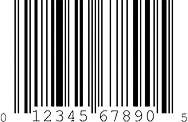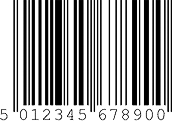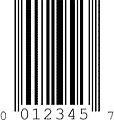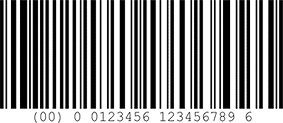- Home
- GS1 Standards
- Barcodes
Barcodes
The GS1 System provides several types of bar code for use by GS1 members depending on the application. The reasons for this vary but because different bar code types have different strengths and weaknesses, GS1 selects the bar code that best fits the application the best. The bar codes used by GS1 include EAN/UPC, GS1 DataBar, GS1-128, ITF-14, GS1 DataMatrix, and Composite Component.
Key Concepts
EAN/UPC
- Are specified for retail Point-of-Sale(POS) because they are designed for the high volume scanning environment
- Used at POS and in logistics must be printed larger than the "target" size to accommodate logistics scanning
- Limited to carrying GS1 Keys and special identifiers for restricted applications like variable measure trade items and internal numbering
GS1 DataBar
- A family of symbols that can be scanned at retail point-of-sale(POS), are smaller than EAN/UPC and can carry additional information such as serial numbers, lot numbers of expiry dates
- A subset of GS1 DataBar bar codes designed for use at POS are being considered by a GS1 Board Task Force for future adoption because GS1 DataBar can carry all GS1 Keys and attributes and do so in a smaller space than EAN/UPC
- GS1 DataBar symbols are already approved for global use on healthcare items that do not cross POS
GS1-128
- GS1-128(formerly UCC/EAN-128) bar codes can carry all GS1 Keys and attributes but cannot be used to identify items crossing POS
ITF-14
- ITF-14 bar codes can only carry GTINs, can be printed directly on corrugated cartons, but cannot be used to identify items crossing POS
GS1 DataMatrix
- GS1 DataMatrix is the only "2D Matrix" symbol specified for use by GS1 and is becoming increasingly the symbol of choice for many in healthcare
- Because GS1 DataMatrix requires camera based scanners it is currently specified for healthcare items not crossing POS and direct part marking
Composite Component
- Composite Component is the only "2D linear" symbol specified by GS1
- It is called a component because it is only used with a linear bar code like GS1-128 or GS1 DataBar
Barcode Gallery
Our Barcode gallery shows a sample of all GS1 barcode symbols
EAN/UPC

- UPC-A Version
- 12 Numeric
- GTIN-12 and Select Applications
- Omnidirectional(for Point-of-Sale)

- EAN-13 Version
- 13 Numeric
- GTIN-13 and Select Applications
- Omnidirectional(for Point-of-Sale)

- UPC-E Version
- 12 Numeric zeros suppress according to rules
- GTIN-12 with lead "0" and Select Applications
- Omnidirectional(for Point-of-Sale)

- EAN-8 Version
- 8 Numeric
- GTIN-8 and Select Application
- Omnidirectional(for Point-of-Sale)
GS1 DataBar

- GS1 DataBar Omnidirectional
- 14 Numeric
- GTIN-8 / 12 / 13 / 14
- Omnidirectional

- GS1 DataBar Expanded
- Maximum 74 Numeric/41 Alphanumeric
- All GS1 keys and Application Identifiers
- Omnidirectional

- GS1 DataBar Expanded
- Maximum 74 Numeric / 41 Alphanumeric
- All GS1 keys and Application Identifiers
- Omnidirectional

- GS1 DataBar Expanded Stacked
- Maximum 74 Numeric/ 41 Alphanumeric
- All GS1 keys and Application Identifiers
- Omnidirectional

- GS1 DataBar Limited
- 14 Numeric
- GTIN-8 / 12 / 13, and 14
- Lead digit 0 or 1
- Not Omnidirectional

- GS1 DataBar Truncated
- 14 Numeric
- GTIN-8 / 12 / 13 / 14
- Not Omnidirectional

- GS1 DataBar Stacked
- 14 Numeric
- GTIN-8 / 12 / 13 / 14
- Not Omnidirectional
GS1-128

- GS1-128
- 48 Alphanumeric capacity
- Carries Application Identifiers
- Unique GS1 Identifier
- Not Omnidirectional
ITF-14

- ITF-14
- Interleaved 2 of 5
- 14 Numeric
- GTIN-12 / 13 / 14
- Not Omnidirectional
GS1 DataMatrix

- GS1 Datamatrix(version ECC 200)
- 3116 Numeric capacity
- 2335 Alphanumerics capacity
- Carries Application Identifiers
- Unique GS1 Identifier
- Camera-based(imaging) scanners only
Composite Component

To learn more about Identifition Numbers, please click here to visit GS1 Global Website
